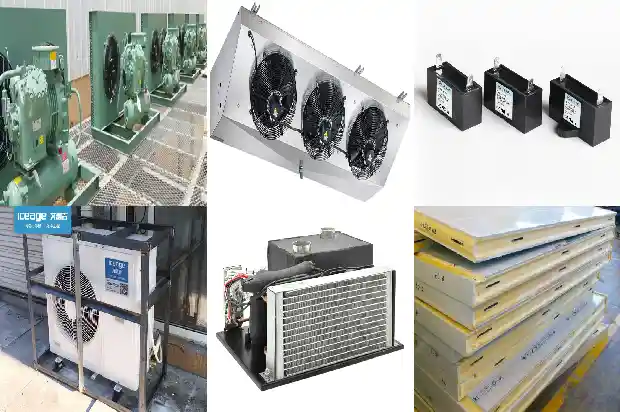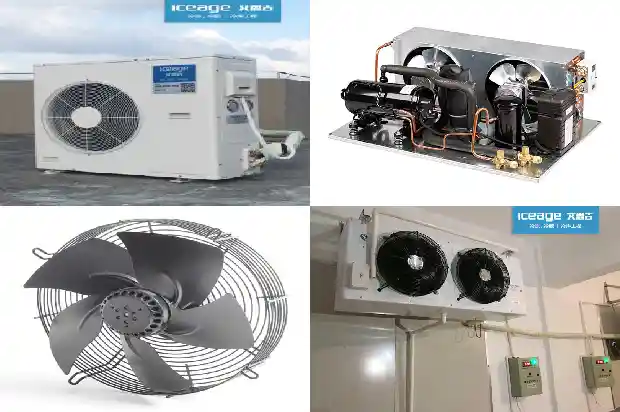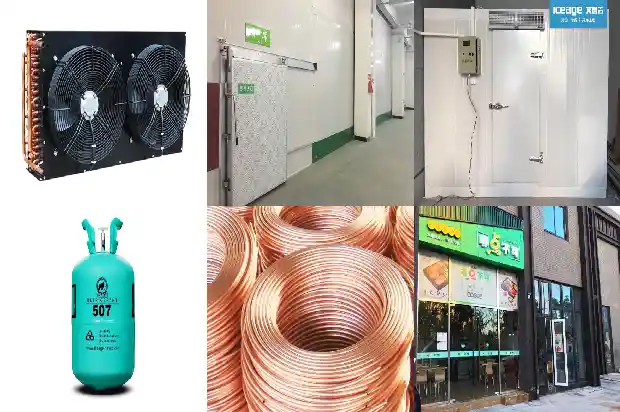HVAC (Heating, Ventilation and Air Conditioning) — The Influence of Lubricating Oil on the Refrigeration System
2025-04-24
- Requirements of the Refrigeration System for Lubricating Oil
(Special Oil for Bitzer Compressors)
Whether the lubricating oil is suitable for the refrigeration system mainly depends on whether the characteristics of the lubricating oil can meet the requirements. The main factors for evaluating the quality of lubricating oil are: - Viscosity
- Miscibility with the Refrigerant
- Thermochemical Stability
- Water Absorption
- Viscosity determines the load-carrying capacity of the oil film, the frictional power consumption, and the sealing ability in the sliding bearing. A higher viscosity means stronger load-carrying capacity and better sealing performance, but the flow resistance is also greater.
Automobile air conditioners require lubricating oil with a relatively high viscosity, while fixed refrigeration systems, especially household refrigerators, require lubricating oil with a lower viscosity. The main reason is that high-viscosity lubricating oil may form a "wax blockage" or an "oil bullet" phenomenon in the capillary tube, affecting the normal operation of the capillary tube.
(Ubbelohde Viscometer) - Miscibility with the Refrigerant If the miscibility is good, it is not easy to form an oil film on the inner surface of the heat transfer tubes of the heat exchanger, which is beneficial to heat transfer. Otherwise, it will cause the evaporation temperature to decrease (on the premise that the evaporation pressure remains unchanged), and the refrigeration effect of the evaporator will decline.

In addition, when the miscibility is good, there will be no pooling phenomenon in the heat exchanger, which is beneficial for the oil return of the compressor.
However, miscibility makes the oil thinner, reducing the viscosity of the oil, resulting in an overly thin oil film in the compressor, which affects the lubrication of the compressor. - Thermochemical Stability In a system where the refrigerant, oil, and metal coexist, high temperatures will promote chemical reactions of the lubricating oil, leading to the decomposition and deterioration of the oil, and the formation of sediments and coke. The acid generated after the decomposition of the lubricating oil will corrode the electrical insulation materials.
- Water Absorption If the lubricating oil has strong hydrophilicity, it will carry a certain amount of water into the system. In the capillary tube, the water forms ice crystals and blocks the system, thus forming an "ice blockage" phenomenon. Therefore, in a system using hydrophilic lubricating oil, a drying filter must be installed.

- Influence of Lubricating Oil on the Compressor
- The oil content in the refrigerant will also affect the working process of the air valve and change the thermodynamic properties of the refrigerant, etc., resulting in a decrease in the refrigeration capacity and performance coefficient of the compressor.
- The power consumption of the compressor increases with the increase of the oil content, while the exhaust temperature is just the opposite, decreasing with the increase of the oil content.
- In addition, a certain amount of refrigerant will dissolve in the lubricating oil in the exhaust pipeline of the compressor, reducing the actual exhaust volume of the compressor.
- Mechanical Damage:
Since a certain amount of refrigerant is dissolved in the lubricating oil at the air inlet of the compressor, the viscosity of the lubricating oil will decrease, resulting in a decline in the lubrication effect, and it is easy to cause damage to the mechanical components of the compressor. - Liquid Slugging The volume of the lubricating oil increases due to the dissolution of the refrigerant. During the startup process of the compressor, the pressure in the crankcase drops, causing the refrigerant dissolved in the lubricating oil to boil, generating a large amount of foam. It is possible to carry a large amount of oil from the crankcase into the cylinder, resulting in liquid slugging and damaging the equipment.
- Influence of Lubricating Oil on the Condenser When the oil content in the refrigerant is very low (about 0.01%), the heat transfer coefficient in the condenser reaches a maximum value, but the increase is not significant compared with that of the pure refrigerant. Generally, the heat transfer coefficient decreases with the increase of the oil content.
At the same time, since the lubricating oil dissolves in the refrigerant, it will cause the viscosity of the refrigerant to increase, resulting in an increase in the pressure drop.
Overall, the presence of lubricating oil will weaken the condensation heat transfer, increase the heat transfer temperature difference of the condenser, and raise the condensation pressure. - Influence of Lubricating Oil on the Capillary Tube The reasons why the oil content in the refrigerant affects the flow rate of the capillary tube mainly include two aspects:
- Because the viscosity of the oil is much higher than that of the refrigerant, a small amount of oil in the refrigerant will increase the viscosity of the mixture and the corresponding flow resistance, and make the refrigerant reach the saturated state in advance, resulting in a decrease in the flow rate.
- The surface tension of the oil is much higher than that of the refrigerant. The oil content in the refrigerant will increase the surface tension of the mixture, hinder the evaporation of the refrigerant, thus increasing the underpressure of vaporization, delaying the evaporation of the refrigerant, and thus increasing the flow rate of the capillary tube.
There may be a phenomenon of separation between the lubricating oil and the refrigerant in the capillary tube, which will affect the operation of the capillary tube. Since the diameter of the capillary tube of small refrigeration equipment (such as household refrigerators and air conditioners) is very small (about 0.6 mm), serious phase separation will lead to the "wax blockage" phenomenon.
- Influence of Lubricating Oil on the Evaporator
I. Influence on Heat Transfer, Heat Transfer Coefficient, etc.
A Small Amount of Lubricating Oil:
A small amount of lubricating oil dissolved in the refrigerant can increase the surface tension of the refrigerant, thus changing its surface wettability to the pipe wall. In addition, it will also generate foam in the pipe, increasing the wetted area between the liquid in the pipe and the pipe wall. At the same time, it will thin the liquid film and distribute it more evenly along the pipe wall, strengthening the heat transfer effect and thus increasing the evaporation heat transfer coefficient.
A Larger Amount of Oil Content:
- When the oil content is high, the vapor in the evaporator is basically pure refrigerant gas, and the oil component is extremely small. With the progress of evaporation, the oil content in the liquid phase gradually increases, and an oil film will be formed on the inner surface of the heat exchanger, reducing the heat transfer coefficient, making the evaporation curve decline, and increasing the heat transfer temperature difference.
- At the same time, part of the unevaporated refrigerant is dissolved in the lubricating oil at the outlet of the evaporator, and the latent heat of this part cannot be fully utilized, resulting in a decrease in the refrigeration capacity.
- The presence of lubricating oil in the evaporator will affect the formation of bubbles during the boiling of the refrigerant, reduce the generation speed and frequency of bubbles, and weaken the heat transfer in the nucleation process, thus reducing the heat transfer effect.
II.
Influence on the Pressure Drop
- At the end of the evaporator, with the evaporation of the refrigerant and the decrease in the solubility of the refrigerant in the lubricating oil due to the increase in temperature, the refrigerant content in the mixture is getting lower and lower, and the viscosity of the mixture gradually increases, directly resulting in a decrease in the heat transfer coefficient and an increase in the pressure drop at the end of the evaporator.
- When the oil content reaches 5%, compared with the situation without lubricating oil, the pressure drop doubles.
The increase in the pressure drop, on the one hand, reduces the suction pressure of the compressor, resulting in a decrease in the compression efficiency of the compressor; on the other hand, it is conducive to the release of the refrigerant dissolved in the lubricating oil, thus improving the heat transfer effect of the evaporator.
III. Stratification Phenomenon
The different dissolution amounts of the refrigerant in each component of the system cause the migration of the refrigerant in the oil.
The refrigerant/oil mixture will show a stratification phenomenon with the decrease of temperature, and the lubricating oil is likely to accumulate in the capillary tube and the evaporator, thus affecting their heat transfer effect and reducing the performance of the refrigerant.
The most likely place for phase separation is the evaporator, because the refrigerant evaporates in the evaporator, and thus a liquid oil film will be formed on the inner surface of the pipeline in the evaporator.
The viscosity of the oil film is mainly determined by the concentration of the lubricating oil in the liquid phase. When the viscosity of the oil film is very high, the flow velocity of the refrigerant vapor is not enough to carry this lubricating oil out of the evaporator, so it accumulates in the evaporator.
- Influence of Lubricating Oil on the Pipeline The lubricating oil will adhere to the wall surface to form an oil film when flowing in the system.
- For lubricating oil and refrigerant that are immiscible, this problem can be solved by installing an oil separator at the exhaust port of the compressor.
- This is not possible for the more commonly used miscible lubricating oil. The lubricating oil enters the circulation together with the refrigerant until it returns to the compressor through the air inlet again. In this way, it is necessary to consider the flow of the lubricating oil in components such as the pipeline, especially the vertical pipeline, because it is very difficult for the lubricating oil to flow upward against the influence of gravity and viscosity. Thus, the refrigerant vapor must have a relatively high flow velocity, but this will also cause an increase in the pressure drop.
- In the low-temperature area of the evaporator and the return air pipe, when the temperature rises, the viscosity of the mixed liquid increases due to the decrease in the refrigerant content in the oil; in the high-temperature area, the amount of refrigerant dissolved is very small, and the main component of the mixed liquid is lubricating oil, and its viscosity decreases with the increase of temperature.
Thus, there is a "maximum viscosity". When designing the pipeline, the maximum viscosity and the inclination angle of the pipeline should be the main basis for determining the pipe diameter and the flow velocity of the gas in the pipe.
- Conclusion
- For the Freon refrigeration system:
When the oil content in the system is low, the mass flow rate of the compressor increases, and the evaporation and condensation heat transfer performance is enhanced;
When the oil content is high, the power consumption of the compressor increases, the actual exhaust volume decreases, and the exhaust temperature decreases; the evaporation and condensation heat transfer coefficient decreases, and the frictional pressure drop along the way increases; the length of the liquid section and the mass flow rate in the capillary tube decrease, resulting in a decrease in the refrigeration capacity of the system. - The entry of refrigeration oil into the refrigeration system will cause phenomena such as "pooling" of lubricating oil in the heat exchanger, "wax blockage" and "ice blockage" in the capillary tube, oil shortage in the compressor, and a decline in the lubrication effect.
Therefore, it is necessary to rationally design the system and its components, control the oil content in the system, ensure that the refrigerant in the circulation can smoothly return to the compressor, and avoid oil shortage in the compressor.
Related Articles
- Construction Methods of Pre-reservation and Pre-embedding in HVAC Engineering
- Eight Quality Problems in HVAC Installation Construction and Corrective Measures
- HVAC Construction Technology and Management: All Key Points to Note Are Here!
- Understand These 50 Refrigeration and HVAC Terms to Make You More Professional
- Summary of HVAC Design Parameters for Residential Buildings
- HVAC - Comprehensive Knowledge You Must Know about Cooling Towers
- The Most Comprehensive Popular Science of Refrigeration and HVAC Basic Knowledge Across the Network!
- How to Set Fire Dampers Optimally in HVAC Systems?
- HVAC - Construction Details for Condensate Water Drainage
- HVAC - Common Auxiliary Components of the Refrigeration System
- HVAC - Solving the 5 Common Problems in the Refrigeration System
- HVAC - Concise Explanation of Refrigeration Principles
- Detailed Explanation of HVAC Pipeline Integration and Pipe Shaft Layout
- HVAC Design | Basics of Cooling Towers
- 【HVAC Design Summary】 - Free Cooling with Cooling Towers
- Obscure Knowledge of Static Pressure, Dynamic Pressure, Latent Heat and Sensible Heat in the HVAC Industry
- Common Faults of HVAC Fan Coil Units
- Myths about "condensate water" in HVAC construction. Know more
